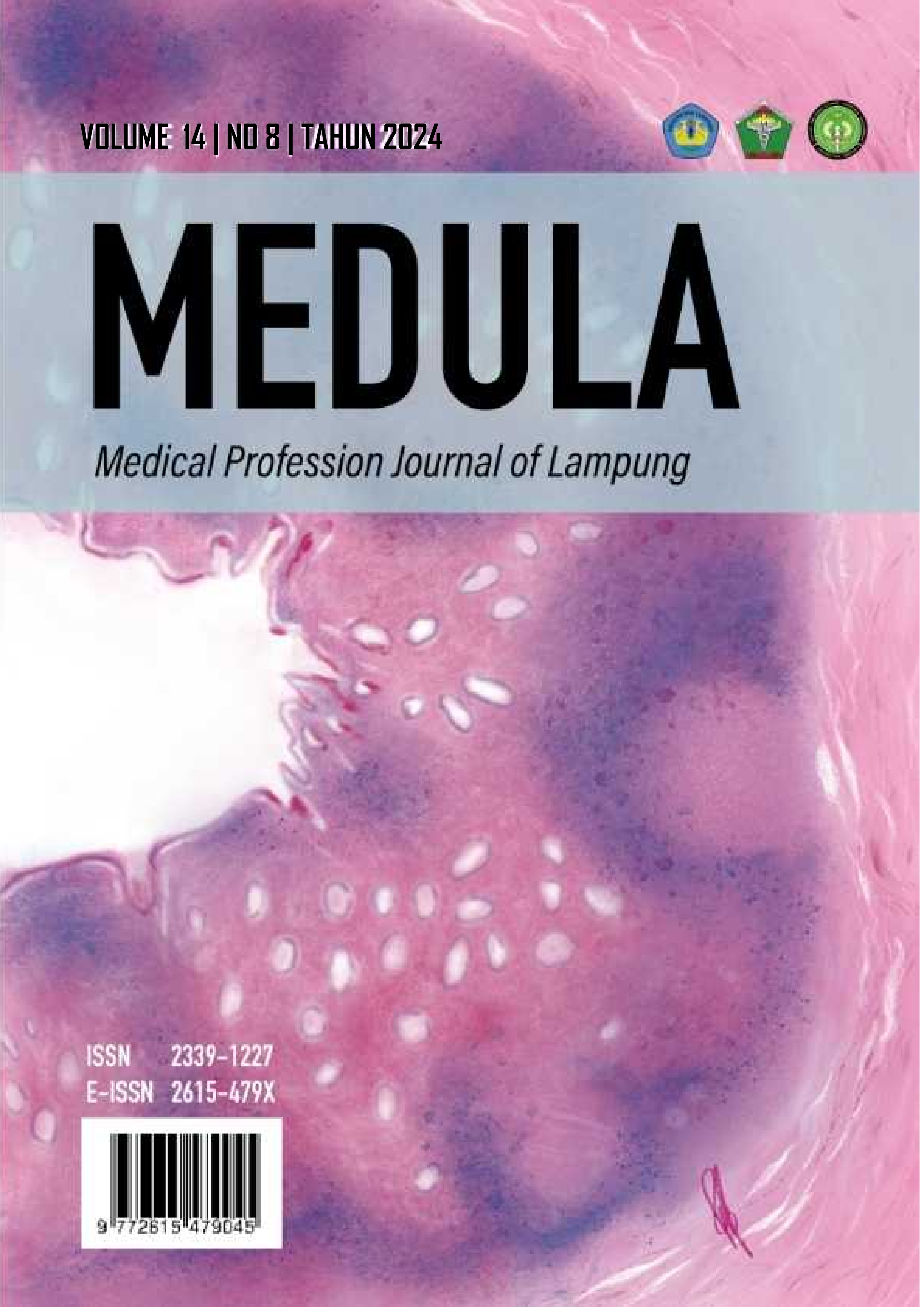Fournier's Gangrene of the Scrotum in Type 2 Diabetic Patients
DOI:
https://doi.org/10.53089/medula.v14i8.1175Abstract
Fournier's Gangrene (FG) is a rare but progressive and life-threatening necrotizing fasciitis (NF) with a prevalence rate of approximately 1.6 cases per 100,000 males annually. FG is often caused by polymicrobial infections, with common sources being urological diseases in the perianal region. A 35-year-old male presented with a painful boil in the lower scrotal area. The lesion ruptured, discharging pus mixed with blood and emitting a foul odor. The wound progressively enlarged, extending from superficial layers to the peripheral nervous system. The patient had a one-year history of diabetes mellitus (DM) with an HbA1C of 7.8% and a random blood glucose level of 98 mg/dL. Based on culture, radiological, and laboratory findings, a diagnosis of scrotal FG was established. The patient underwent debridement from the scrotum to the abdominal wall, including both iliac regions. Regular post-debridement wound evaluations were conducted to ensure the removal of necrotic tissue. Broad-spectrum antibiotics, such as ceftriaxone and metronidazole, were administered to reduce systemic toxicity, inhibit infection progression, and eliminate causative microorganisms. Early and radical debridement of necrotic and non-viable tissue is crucial in halting infection progression, especially in patients with type 2 DM. The cornerstone of FG management includes hemodynamic stabilization, systemic broad-spectrum antibiotic therapy, and surgical debridement. Supportive care, such as hyperbaric oxygen therapy, may be beneficial in certain FG cases. The mortality rate for FG is considerably high, with studies indicating rates ranging from 17% to 28% in Indonesia. Diabetes mellitus and infections with Clostridium perfringens have been identified as independent risk factors for in-hospital mortality among male FG patients.
FG is a medical emergency requiring prompt diagnosis and aggressive treatment, including surgical debridement and broad-spectrum antibiotics. Early intervention is essential to improve patient outcomes.
References
Shyam DC, Rapsang AG. Fournier's gangrene. Surgeon. 2013 Aug;11(4):222-32.
Bruckner A. Fitzpatrick's Dermatology in General Medicine. 9th ed. New York: McGraw Hill; 2019. p. 2770-2880.
Hagedorn JC, Wessells H. A contemporary update on Fournier's gangrene. Nat Rev Urol. 2017 Apr;14(4):205-11.
Voelzke BB, Hagedorn JC. Presentation and diagnosis of Fournier gangrene. Urology. 2018 Apr;114:8-13.
Kihiczak GG, Schwartz RA, Kapila R. Necrotizing fasciitis: a deadly infection. J Eur Acad Dermatol Venereol. 2006 Apr;20(4):365-9.
Morua AG, Lopez JA, Garcia JD, Montelongo RM, Guerra LS. Fournier's gangrene: our experience in 5 years, bibliographic review and assessment of the Fournier's gangrene severity index. Cir Cir. 1998;62(7):532-40.
Eskitaşçioğlu T, Özyazgan İ, Çoruh A, Günay GK, Altıparmak M, Yontar Y, et al. Experience of 80 cases with Fournier's gangrene and "trauma" as a trigger factor in pathogenesis. Ulus Travma Acil Cerrahi Derg. 2014 Jul;20(4):265-74.
Matsuura H, Iwase K. Fournier Gangrene. Cleve Clin J Med. 2018 Sep;85(9):685-6.
Costa IM, Cabral AL, Pontes SS, Amorim JF. Necrotizing fasciitis: new insights with a focus on dermatological aspects. An Bras Dermatol. 2004 Mar-Apr;79(2):211-24.
Igietseme JU, Omosun Y, Black CM. Bacterial sexually transmitted infections (STIs): a clinical overview. In: Tang YW, Sussman M, Liu D, Poxton I, Schwartzman J, editors. Molecular Medical Microbiology. 2nd ed. London: Academic Press; 2015. p. 1403-20.
Passos MR. Donovanosis. In: Gross G, Tyring SK, editors. Sexually Transmitted Infections and Sexually Transmitted Diseases. Berlin: Springer; 2011. p. 161-72.
LaChance A. Necrotizing fasciitis, necrotizing cellulitis, and myonecrosis. In: Kang S, Amagai M, Bruckner A, et al., editors. Fitzpatrick's Dermatology in General Medicine. 9th ed. New York: McGraw Hill; 2019. p. 2770-80.
Göktaş C. Factors affecting the number of debridements in Fournier's gangrene: our results in 36 cases. Ulus Travma Acil Cerrahi Derg. 2012 Jan;18(1):43-8.
Singh A, Ahmed K, Aydin A, Khan MS, Dasgupta P. Fournier's gangrene: a clinical review. Arch Ital Urol Androl. 2016 Sep;88(3):157-64.
Downloads
Published
How to Cite
Issue
Section
License
Copyright (c) 2024 Medical Profession Journal of Lampung

This work is licensed under a Creative Commons Attribution-ShareAlike 4.0 International License.














